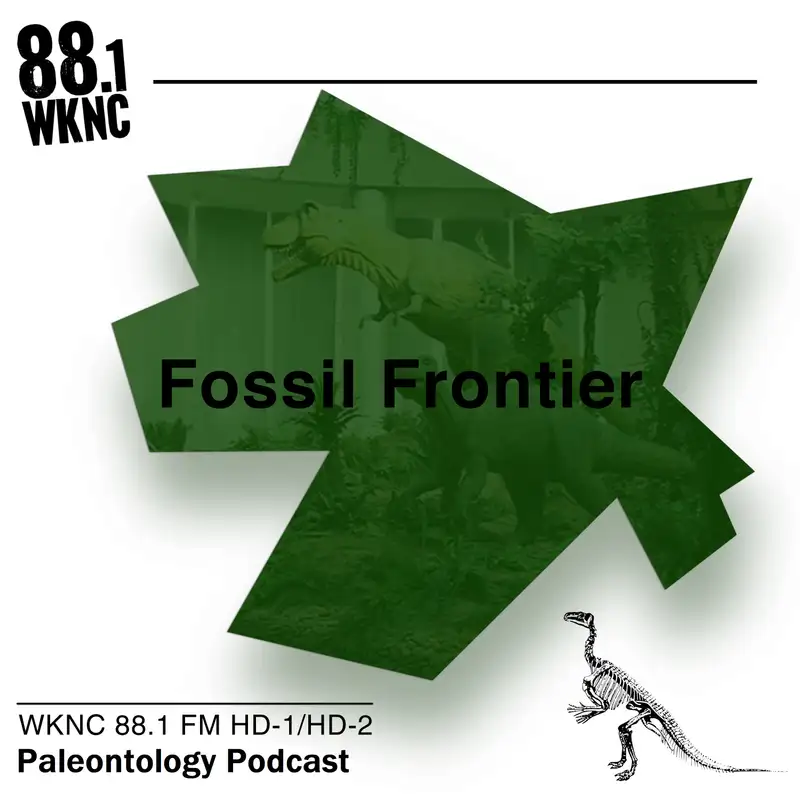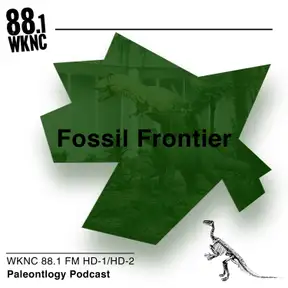Triassic Cuddle: The Story of Two Unlikely Lovers
Download MP3Scrimble 0:06
Hello everybody. I'm Scrimble and welcome to the 10th episode of my podcast, fossil frontier, a paleontology podcast brought to you by wknc 88.1 this show will be dedicated to talking about my favorite fossils and prehistoric phenomena, we're going to explore some of Earth's ancient treasures and uncover the stories that they have to tell. So if that's something you're into, you better lock in, because this week we're talking about the Triassic cuddle, the unlikely pair that would be preserved in time. Okay, So picture this. It's 1975 and you're James Kitching, a paleontologist who just discovered the fossilized burrow of a thrinaxodon from about 250 million years ago in South Africa. This was a small carnivorous mammal, and unfortunately, it was killed when a flash flood swept water and sediment into the burrow. So you're investigating this burrow, which is now a mass of fossilized rock and bone. You crack it open to reveal that there's more bones in there than you originally thought, much more than if it belonged to just one animal. So you dig further, only to reveal the remains of a Broomistega, a salamander like amphibian curled up next to the throne accident with their bodies intertwined. They almost looked like they were cuddling, encased forever in stone. But why were these two completely different species in the same burrow? Were they besties having a sleepover? Were they secret lovers finding a moment of escape inside their underground burrow, or was there something more sinister at play? Well, first off, it's important to know about the burrow itself. You see, during the Triassic Period, South Africa was very dry and warm, kind of like a desert. There was very little vegetation around. So this left the perfect niche open for the thrinanxodon they would burrow underground to stay cool and take shelter, which is why the burrow that was fossilized likely belonged to the thrinaxodon before its demise, these mammals were also carnivores, mostly feeding on insects and smaller animals like the broomistega. It's also important to note that the broomistega was severely injured when it died in the burrow, so the likely conclusion here is that the thrinaxodon took the broomistega into its burrow after attacking it to eventually eat it. Right? Well, probably not. You see, while the broomistega was injured, the tooth marks found on its body did not match the thrinaxodon, and it's not likely that the mammal would have evolved his skills to stash away food before eating it. So that theory is out of the picture. Another thing to remember is that the whole reason why the burrow was fossilized was because of flash flooding filling it with sediment. Perhaps the broomistega was just swept into the burrow with the flood water. But that couldn't be it either. Unfortunately, the opening of the enclosure was very small, likely only just big enough for the broomistega to fit in headfirst. So it couldn't just be a coincidence that the amphibian made its way into the burrow. It went there intentionally, knowing that there was a deadly predator inside. Maybe then the thrinaxodon was incapacitated in some way, and could not defend its territory. Well, first off, it couldn't have been dead. Based on the curvature of the thrinaxodon spine, the mammal could not have undergone rigor mortis, and so it was likely alive. But the theory that scientists have agreed on is that the thrinaxodon was simply asleep. You see animals in dry, warm climates practice estivation, which is kind of like hibernation, to keep them cool. This is also backed up by the position of its limbs in the burrow, right by its head, as if it were resting, so the thrinaxodon could have been estivating and therefore in a deep sleep when the broomistega approached. But why would the amphibian even go into the burrow in the first place? Well, remember that it was severely injured. It had several broken ribs and tooth marks in its skull. Also, juveniles of the species, as well as most amphibians to this day, are known to enter burrows of other animals for protection, so it likely hidden there to recover from its injuries. So with that being said, picture this once again. It's the early Triassic period in Europe, Broomistega, wandering the desert of South America. A few weeks back, you were attacked, and thankfully, you escaped, but you were left with many injuries that cause you excruciating pain when you move or breathe. You know you need to find some place you can recover, but the unforgiving climate of the desert does not let up. You wander on each step, putting you in grueling pain, until you come upon a burrow just big enough for you to fit into with the choice between the hot sun and the cool, calm burrow you step in only to be met with another predator, the thrinaxodon. Fortunately, it seems to be sleeping, so you cuddle up next to it as the throne accident, you may stir in your sleep, but with no major threat present, you allow the brumastega to stay here while you estivate, as you both get your much needed rest, nestled up next to each other, you find an unlikely kinship. But that won't last for long. Suddenly, floodwaters come crashing into the burrow, filling it up and leaving less and less air to breathe. Sediment has closed off the entrance so there's no escape. Both animals are on high alert, seeing the water rise around them, they're left with no choice. They cuddle up close as the floodwater pushes in, normally, the thrinaxodon would have eaten the broomistega, but in this moment, they look into each other's eyes, drowning out the world and being present with each other, and as the last few air bubbles disappear in the burrow, the throne accident uses its last breath to whisper, I Love you. Okay, maybe that last part didn't happen, but it does set the scene for what those final moments may have been like between the two. And ultimately, the Triassic cuddle fossil represents how the natural behavior of both animals led to one of the most unnatural scenes, predator and prey curled up together, fossilized forever in that moment of fear, but fossilized together sleeping in the burrow while a lot of the time the natural world, especially the ancient world, with its huge, terrifying dinosaurs or giant predators, may seem cruel and uncaring, it's little moments like this between an unlikely pair, that just goes to show that there truly is kindness all around you. Thank you for listening to the 10th episode of fossil frontier. This has been a wknc podcast. Good night, and I love you. The audio use in this podcast was song, Thresh nature, field recording, garden atmo recorded by Garuda 1982 under Creative Commons license.
Transcribed by https://otter.ai

